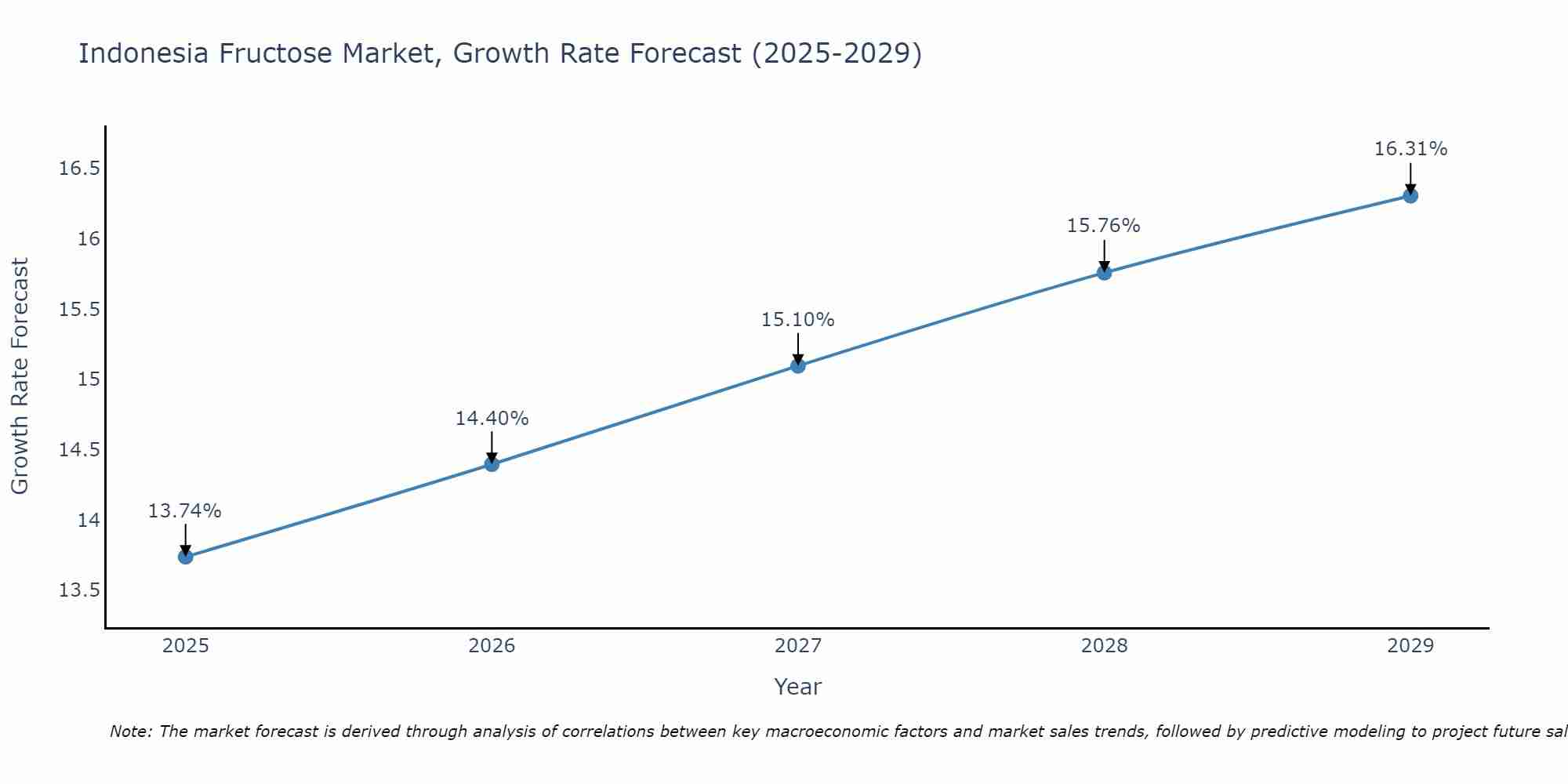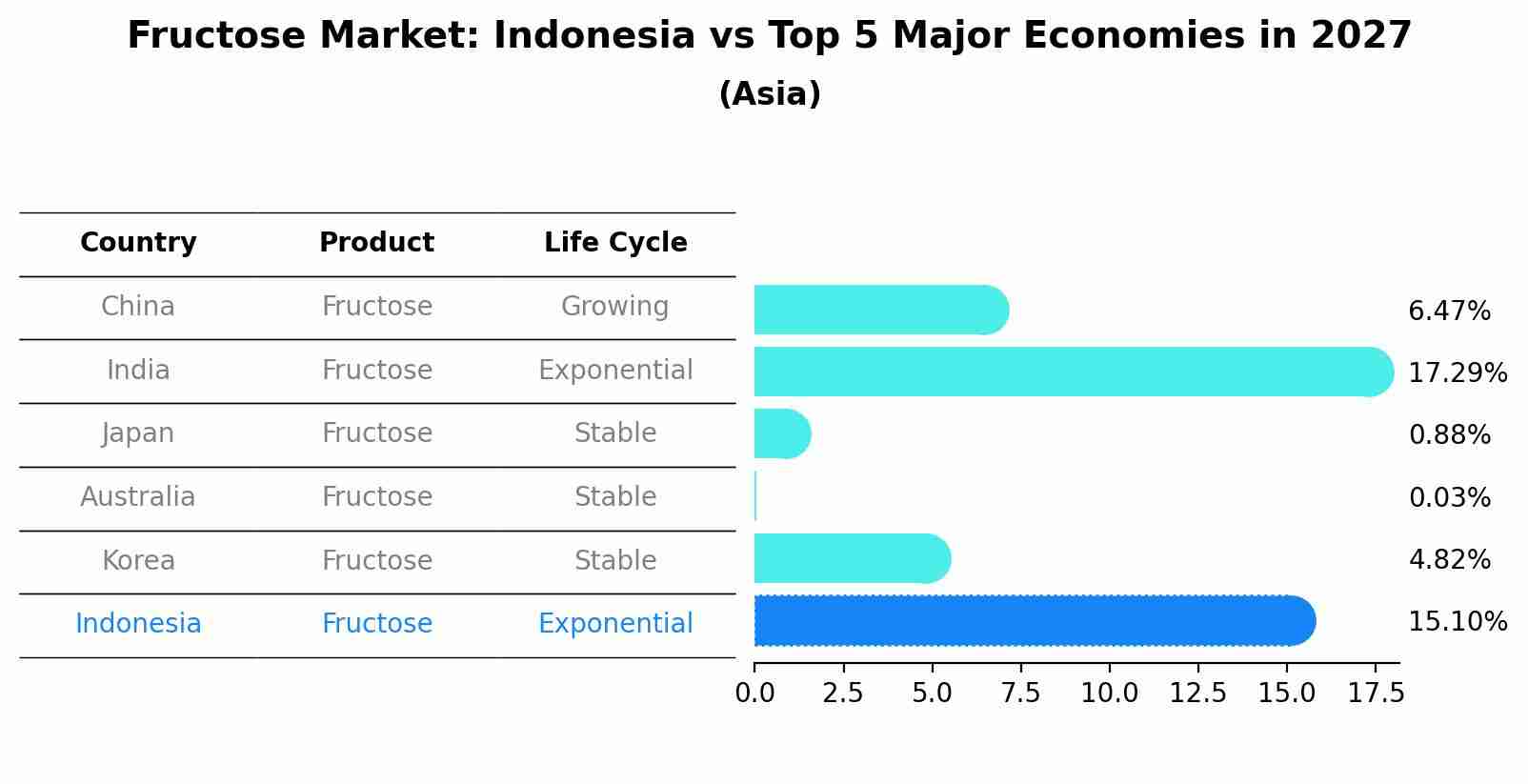Indonesia Fructose Market (2025-2031) Outlook | Trends, Share, Value, Size, Industry, Growth, Analysis, Revenue, Forecast & Companies
| Product Code: ETC106247 | Publication Date: Jul 2023 | Updated Date: Apr 2025 | Product Type: Report | |
| Publisher: 6Wresearch | No. of Pages: 70 | No. of Figures: 35 | No. of Tables: 5 | |
Indonesia Fructose Market Size Growth Rate
The Indonesia Fructose Market is likely to experience consistent growth rate gains over the period 2025 to 2029. The growth rate starts at 13.74% in 2025 and reaches 16.31% by 2029.

Fructose Market: Indonesia vs Top 5 Major Economies in 2027 (Asia)
By 2027, the Fructose market in Indonesia is anticipated to reach a growth rate of 15.10%, as part of an increasingly competitive Asia region, where China remains at the forefront, supported by India, Japan, Australia and South Korea, driving innovations and market adoption across sectors.

Indonesia Fructose MarketSynopsis
The Indonesia fructose market is estimated to be valued at USD 5.3 billion in 2025 and is projected to reach USD 10.4 billion by 2031, registering a CAGR of 11% during the forecast period 2025-2031. Fructose is a type of sugar that occurs naturally in fruits and vegetables, also known as fruit or levulose sugar, which has been widely used as an alternative sweetener for table sugar due to its low glycemic index and sweetness potential. It can be found in various forms such as corn syrup solids, high fructose syrup (HFS), honey powder/molasses powder/apricot kernel meal/apple concentrate juice, and other crystalline forms.
Market Trends
Increasing awareness about healthy diet among consumers owing to rising health concerns regarding obesity has driven the growth of the Indonesia fructose market over recent years Carbohydrate intake from dietary sources has increased significantly due to changing lifestyle trends such as urbanization and hectic lifestyles have further contributed towards growing demand for convenient food products with reduced calories content leading manufacturers are increasingly focusing on launching new variants of foods containing natural sweeteners like fructose which is likely fuel market growth over coming years Increasing health consciousness among customers coupled with growing popularity of functional beverages containing natural sweeteners will create lucrative opportunities for industry participants.
Market Drivers
Growing demand for food & beverage items fortified with low calorie ingredients have led manufacturers focus on introducing healthier products offerings available in the form of convenience snacks such as energy bars granolas nutrition shakes protein bars etc This trend is expected gain traction over next few years since fructose consumed through these products offer low-calorie benefit compared to other conventional sugars In addition increasing expenditure power per capita along with rapid expansion of hypermarket chains across Indonesia will provide substantial traction toward sales volume Moreover introduction favorable government initiatives directed towards promoting consumption healthy processed foods will lead bolster product penetration traditionally unorganized segment.
COVID-19 Impact on the Market
Due to the measures imposed by the Indonesia government in response to the COVID-19 pandemic, such as social distancing and travel restrictions, there has been an impact on the fructose market in Indonesia. The production of fructose has seen a significant decline due to disruptions in supply chains caused by these restrictions. Additionally, with people spending more time at home and having less disposable income, there has been a decrease in demand for sweets and other food products containing high amounts of sugar or fructose. This combined effect has led to fewer orders from local manufacturers who rely heavily on imported ingredients before producing their products that contain fructose.
Challenges of the Market
The main challenge facing Indonesia fructose market is its reliance on imports for key components used in manufacturing processes. Local manufacturers have limited access to raw materials needed for producing finished goods containing high levels of fructose which makes them vulnerable to external factors like price fluctuations or disruption of supply chain during times like COVID-19 pandemic. In addition, most producers are small scale businesses with limited resources which restricts their ability to adapt quickly or invest into research & development activities necessary for developing innovative solutions required for staying competitive against global players entering this market segment over recent years.
Industry Key Players
The major companies operating within this sector are PT Mitra Sugars, Cargill Inc., Tate & Lyle PLC among others. They produce various types of sweeteners including glucose syrups and liquid sucrose that help enhance flavor profile while adding sweetness without compromising texture quality of various food items produced through industrial applications ranging from bakery goods to confectioneries etc.. These companies also offer their expertise services called ?sweetener blending? where they provide complete solution according customer specified requirements regarding type taste associated with particular product range/application area ? all under one roof.
Key Highlights of the Report:
- Indonesia Fructose Market Outlook
- Market Size of Indonesia Fructose Market, 2024
- Forecast of Indonesia Fructose Market, 2031
- Historical Data and Forecast of Indonesia Fructose Revenues & Volume for the Period 2021-2031
- Indonesia Fructose Market Trend Evolution
- Indonesia Fructose Market Drivers and Challenges
- Indonesia Fructose Price Trends
- Indonesia Fructose Porter's Five Forces
- Indonesia Fructose Industry Life Cycle
- Historical Data and Forecast of Indonesia Fructose Market Revenues & Volume By Product for the Period 2021-2031
- Historical Data and Forecast of Indonesia Fructose Market Revenues & Volume By High Fructose Corn Syrup for the Period 2021-2031
- Historical Data and Forecast of Indonesia Fructose Market Revenues & Volume By Fructose Syrups for the Period 2021-2031
- Historical Data and Forecast of Indonesia Fructose Market Revenues & Volume By Fructose Solids for the Period 2021-2031
- Historical Data and Forecast of Indonesia Fructose Market Revenues & Volume By Application for the Period 2021-2031
- Historical Data and Forecast of Indonesia Fructose Market Revenues & Volume By Beverages for the Period 2021-2031
- Historical Data and Forecast of Indonesia Fructose Market Revenues & Volume By Processed Foods for the Period 2021-2031
- Historical Data and Forecast of Indonesia Fructose Market Revenues & Volume By Dairy Products for the Period 2021-2031
- Historical Data and Forecast of Indonesia Fructose Market Revenues & Volume By Confectionary for the Period 2021-2031
- Historical Data and Forecast of Indonesia Fructose Market Revenues & Volume By Bakery & Cereals for the Period 2021-2031
- Historical Data and Forecast of Indonesia Fructose Market Revenues & Volume By Others for the Period 2021-2031
- Indonesia Fructose Import Export Trade Statistics
- Market Opportunity Assessment By Product
- Market Opportunity Assessment By Application
- Indonesia Fructose Top Companies Market Share
- Indonesia Fructose Competitive Benchmarking By Technical and Operational Parameters
- Indonesia Fructose Company Profiles
- Indonesia Fructose Key Strategic Recommendations
Frequently Asked Questions About the Market Study (FAQs):
1 Executive Summary |
2 Introduction |
2.1 Key Highlights of the Report |
2.2 Report Description |
2.3 Market Scope & Segmentation |
2.4 Research Methodology |
2.5 Assumptions |
3 Indonesia Fructose Market Overview |
3.1 Indonesia Country Macro Economic Indicators |
3.2 Indonesia Fructose Market Revenues & Volume, 2021 & 2031F |
3.3 Indonesia Fructose Market - Industry Life Cycle |
3.4 Indonesia Fructose Market - Porter's Five Forces |
3.5 Indonesia Fructose Market Revenues & Volume Share, By Product, 2021 & 2031F |
3.6 Indonesia Fructose Market Revenues & Volume Share, By Application, 2021 & 2031F |
4 Indonesia Fructose Market Dynamics |
4.1 Impact Analysis |
4.2 Market Drivers |
4.3 Market Restraints |
5 Indonesia Fructose Market Trends |
6 Indonesia Fructose Market, By Types |
6.1 Indonesia Fructose Market, By Product |
6.1.1 Overview and Analysis |
6.1.2 Indonesia Fructose Market Revenues & Volume, By Product, 2021-2031F |
6.1.3 Indonesia Fructose Market Revenues & Volume, By High Fructose Corn Syrup, 2021-2031F |
6.1.4 Indonesia Fructose Market Revenues & Volume, By Fructose Syrups, 2021-2031F |
6.1.5 Indonesia Fructose Market Revenues & Volume, By Fructose Solids, 2021-2031F |
6.2 Indonesia Fructose Market, By Application |
6.2.1 Overview and Analysis |
6.2.2 Indonesia Fructose Market Revenues & Volume, By Beverages, 2021-2031F |
6.2.3 Indonesia Fructose Market Revenues & Volume, By Processed Foods, 2021-2031F |
6.2.4 Indonesia Fructose Market Revenues & Volume, By Dairy Products, 2021-2031F |
6.2.5 Indonesia Fructose Market Revenues & Volume, By Confectionary, 2021-2031F |
6.2.6 Indonesia Fructose Market Revenues & Volume, By Bakery & Cereals, 2021-2031F |
6.2.7 Indonesia Fructose Market Revenues & Volume, By Others, 2021-2031F |
7 Indonesia Fructose Market Import-Export Trade Statistics |
7.1 Indonesia Fructose Market Export to Major Countries |
7.2 Indonesia Fructose Market Imports from Major Countries |
8 Indonesia Fructose Market Key Performance Indicators |
9 Indonesia Fructose Market - Opportunity Assessment |
9.1 Indonesia Fructose Market Opportunity Assessment, By Product, 2021 & 2031F |
9.2 Indonesia Fructose Market Opportunity Assessment, By Application, 2021 & 2031F |
10 Indonesia Fructose Market - Competitive Landscape |
10.1 Indonesia Fructose Market Revenue Share, By Companies, 2024 |
10.2 Indonesia Fructose Market Competitive Benchmarking, By Operating and Technical Parameters |
11 Company Profiles |
12 Recommendations |
13 Disclaimer |
- Single User License$ 1,995
- Department License$ 2,400
- Site License$ 3,120
- Global License$ 3,795
Search
Related Reports
- Middle East OLED Market (2025-2031) | Outlook, Forecast, Revenue, Growth, Companies, Analysis, Industry, Share, Trends, Value & Size
- Portugal Occupational Health & Safety Services Market (2025-2031) | Strategy, Consumer Insights, Analysis, Investment Trends, Opportunities, Growth, Size, Share, Industry, Revenue, Segments, Value, Segmentation, Supply, Forecast, Restraints, Outlook, Competition, Drivers, Trends, Demand, Pricing Analysis, Competitive, Strategic Insights, Companies, Challenges
- Netherlands Occupational Health and Safety Services Market (2025-2031) | Strategy, Consumer Insights, Analysis, Investment Trends, Opportunities, Growth, Size, Share, Industry, Revenue, Segments, Value, Segmentation, Supply, Forecast, Restraints, Outlook, Competition, Drivers, Trends, Demand, Pricing Analysis, Competitive, Strategic Insights, Companies, Challenges
- Belgium and Luxembourg Facility Management Market (2025-2031) | Strategy, Consumer Insights, Analysis, Investment Trends, Opportunities, Growth, Size, Share, Industry, Revenue, Segments, Value, Segmentation, Supply, Forecast, Restraints, Outlook, Competition, Drivers, Trends, Demand, Pricing Analysis, Competitive, Strategic Insights, Companies, Challenges
- Russia Women Intimate Apparel Market (2025-2031) | Strategy, Consumer Insights, Analysis, Investment Trends, Opportunities, Growth, Size, Share, Industry, Revenue, Segments, Value, Segmentation, Supply, Forecast, Restraints, Outlook, Competition, Drivers, Trends, Demand, Pricing Analysis, Competitive, Strategic Insights, Companies, Challenges
- Africa Chocolate Market (2025-2031) | Size, Share, Trends, Growth, Revenue, Analysis, Forecast, industry & Outlook
- Global Hydroxychloroquine And Chloroquine Market (2025-2031) | Industry, Trends, Size, Outlook, Growth, Value, Companies, Revenue, Analysis, Share, Forecast
- Saudi Arabia Plant Maintenance Market (2025-2031) | Industry, Size, Growth, Revenue, Value, Companies, Forecast, Analysis, Share & Trends
- Taiwan Electric Truck Market (2025-2031) | Outlook, Industry, Revenue, Size, Forecast, Growth, Analysis, Share, Companies, Value & Trends
- South Korea Electric Bus Market (2025-2031) | Outlook, Industry, Companies, Analysis, Size, Revenue, Value, Forecast, Trends, Growth & Share
Industry Events and Analyst Meet
Our Clients
Whitepaper
- Middle East & Africa Commercial Security Market Click here to view more.
- Middle East & Africa Fire Safety Systems & Equipment Market Click here to view more.
- GCC Drone Market Click here to view more.
- Middle East Lighting Fixture Market Click here to view more.
- GCC Physical & Perimeter Security Market Click here to view more.
6WResearch In News
- Doha a strategic location for EV manufacturing hub: IPA Qatar
- Demand for luxury TVs surging in the GCC, says Samsung
- Empowering Growth: The Thriving Journey of Bangladesh’s Cable Industry
- Demand for luxury TVs surging in the GCC, says Samsung
- Video call with a traditional healer? Once unthinkable, it’s now common in South Africa
- Intelligent Buildings To Smooth GCC’s Path To Net Zero













